ISSN ONLINE(2319-8753)PRINT(2347-6710)
ISSN ONLINE(2319-8753)PRINT(2347-6710)
| Kalpana.P.M, Assistant Professor, Department of Electrical and Electronics Engineering, Velammal Institute of Technology, Chennai, India. |
| Related article at Pubmed, Scholar Google |
Visit for more related articles at International Journal of Innovative Research in Science, Engineering and Technology
This project presents the implementation of PIC microcontroller based wireless architecture for human health monitoring system using the two sensors are used namely, temperature and pulse heart rate. The temperature sensor is used to continuously monitor the body temperature. The pulse heart rate sensor is used to measure the heart rate by sensing the change in blood volume in a finger artery while the heart is pumping the blood. The sensors output are given to the signal conditioning circuit to condition and amplify the sensors output and as a result of voltage value. These sensors output are interfaced with PIC microcontroller and data is transmitted to the node wirelessly using zigbee (MRF24J40), which passed the data’s to a PC. The readings of the sensor are noted and the information is broadcasted into the network. These readings are stored, transmitted, received and displayed data’s in the server continuously. This provides a painless, automated way to collect a large amount of sensors data. Finally, it send these data’s to Visual Basic based software by using the Serial communication port.
Keywords |
| PIC18F46J50, Temperature Sensor, Pulse heart rate sensor, Zigbee, Wireless Architecture, Human health monitoring, Visual Basic. |
INTRODUCTION |
| The current health care systems were structure and optimize for the reacting to crisis and managing illness are facing new health problems, for e.g. a rapidly growing population of elderly and rising the health care spending. The statistical graph represents to suggest that health care needs a major shift toward more scalability and more affordability solutions [15]. The structured of health care systems toward proactive managing of wellness and focusing on to prevent the early detection of diseases. The wearable systems were continuous health monitoring as a technology in helping the transition information to the healthcare. Wearable health monitoring systems allow an individual to monitor the changes in human vital sign and provide to help maintain the health status. |
| In recent technology advanced in physical sensors, microcontrollers and radio frequency on a single chip using wireless networking and nano-fabrication have enabled a new generation of wireless sensor nodes suitable for many applications. One of the most important exciting application domains is health monitoring. A number of sensors that monitor vital signs could be integrate into a Wireless Body Area Network [5]. The WBAN , which is consist of low cost, less weight, and miniature sensors can allow long-term, ambulatory health monitoring instantaneous feedback to the user about the health status and real-time updates of the user’s medical records [12]. In this project proposed the wireless architecture of human health monitoring, to providing with proper health care facilities. The sensors where placed on the patient’s body, to monitored the human health. The function of sensor is to collect data’s from the patient body and to send those information to a PC via short range wireless network. |
HUMAN HEALTH MONITORING |
| A wireless sensor node is designed about advanced PIC microcontroller. The wireless sensor node consists of sensors, signal conditioning, the microcontroller, radio frequency and power supply. A sensor is a hardware device that senses a signal to a change in physical parameter such as temperature. The signal conditioning which is consist of amplification, filtering and isolation processes required to form a sensor output suitable for processing after conditioning. The microcontroller is used as the computing device. The microcontroller which is consist of 44-Pin, Low-Power, High-Performance USB Microcontrollers with nanoWatt XLP Technology. The wireless communication the RF module Zigbee i.e. MRF24J40 is employed. The system is used to design monitoring the human health. A sensor senses the temperature values from the human body. The sensor output voltage interfaced with signal conditioning circuit and amplifying the voltage. That output interfaced with microcontroller and send the information to a PC via wireless transmit using Zigbee. The overview of human health monitoring as shown in figure 1. |
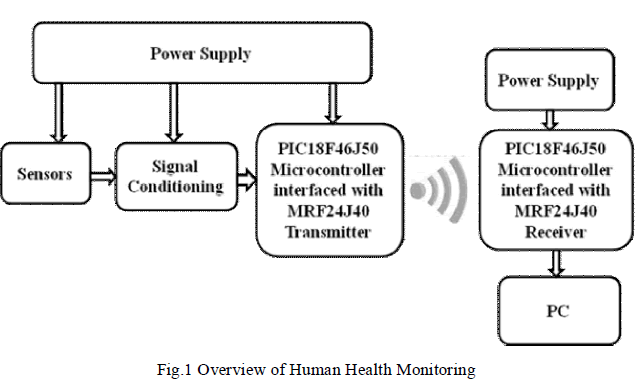 |
SENSOR NODE DESIGN |
| A. NTC Thermistor |
| MA100 is an NTC Biomedical Chip thermistor developed by GE Industrial Sensing and mainly used for biomedical applications. Thermistor is design for used in continuous patient temperature monitoring. The MA100 Thermistor is measure the temperature value in the range of 0° C to 50° C and it is converted temperature values into electric resistance. The size of the MA100 thermistor is 0.762 × 9.52 mm as shown in the figure 3. The size, shape, temperature ranges, and its approved by the medical applications, therefore we have chosen this MA100 thermistor and also get the more accurate temperature readings. The temperature sensor must be placed in skin surface of the body [13]. |
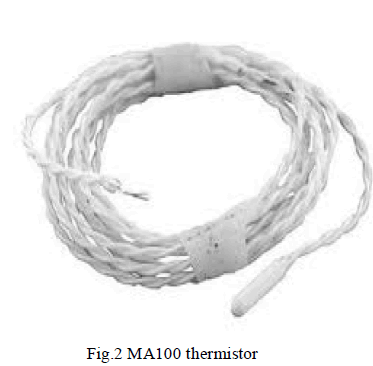 |
| The thermistor which is consist of 3 parts, MA100, the electronic circuit and the battery in the tail. The internal design of thermistor as shown in the figure 2. It is properly enclosed and to avoid the problems with the exterior MA100 thermistor. The electric current range used to power not too high, there is no damages to sensitive skin and others injuries. |
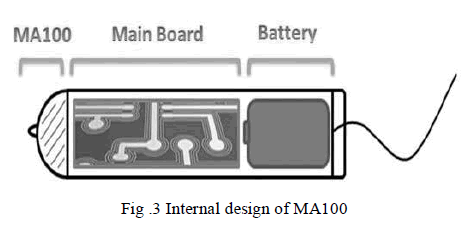 |
| B. Pulse Heart Rate Sensor |
| The heart beat monitoring using microcontroller PIC18f46j50. A pair of LED and LDR is used as sensor for sensing the pulses of heart. The signal is generated when a finger is placed between LED and LDR. OP amp is used for the further processing of the signal generated from the LDR, if finger is placed and some obstacle for light is created, which itself is varying with the pressure of blood in the veins of finger. For a healthy person, these pulses should be nearly equal to 70 to 80 BPM. |
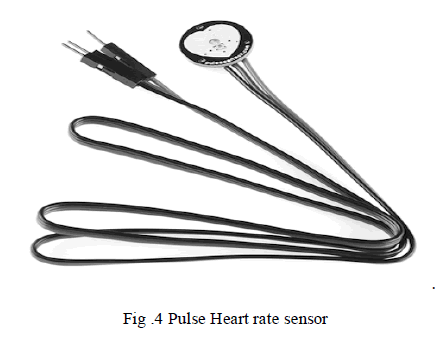 |
| C. PIC8F46J50 Microcontroller |
| The microcontroller PIC18F46J50 is used as the computing device. The microcontroller which is consist of 44-Pin, Low-Power, High-Performance USB Microcontrollers with nanoWatt XLP Technology. The microcontroller, PIC18F46J50 which consist of 13 channels, multiplexed ADC, each with 10-bit resolution. The microcontroller has the source of reference voltage of 2.56V. This PIC18 allows converts analog input signal to a corresponding 10-bit digital number. The temperature sensor voltage is given to the input of the PIC microcontroller. The internal AD converter of the PIC microcontroller is used to measure the value of the temperature. |
| D. MRF24J40 Transceiver |
| The MRF24J40 which consist of 2.4 GHz IEEE Std. 802.15.4 RF Transceiver Module. The dimension of the zigbee is 17.8 mm x 27.9 mm, surface mountable and up to 400 ft. range. This module interfaces with the microcontroller via a 4-wire serial SPI interface. The values of the temperature sensor are noted and the information is broadcasted in the network. |
PROPOSED SYSTEM |
| As the first step, a sensor is a hardware device that senses a signal to a change in a physical condition such as temperature and heart rate. A sensor node is a micro-electronic device powered by a low power source; the attached sensors should be small in size and consume extreme low energy. The thermistor is interfaced with signal conditioning circuit. The output of the sensor analogous voltage is amplified by means of the operational amplifier. The amplified output voltage is interfaced with input of PIC18F46J50 microcontroller. The analog voltage is given to select an ADC pin in PIC microcontroller. The microcontroller, PIC18F46J50 which consist of 13 channels, multiplexed ADC, each with 10-bit resolution. The internal AD converter of the PIC microcontroller is used to measuring the adc value. |
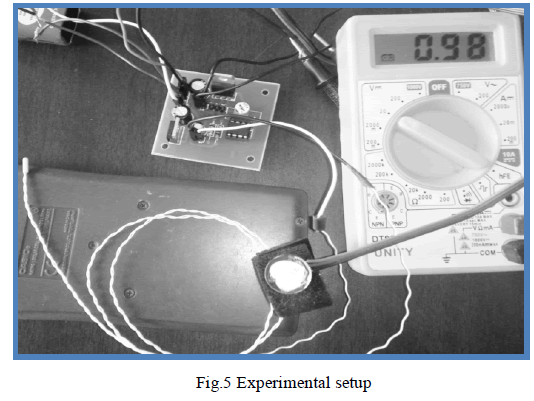 |
| The health condition of a patient is continuously monitored by the sensors. The microcontroller interface with zigbee to transmit the data wirelessly. The values of the temperature values are noted and the information is broadcasted in the network. The experimental setup of the temperature sensor as shown in figure 5 and stored the data’s information in the PC continuously as shown in figure 6. |
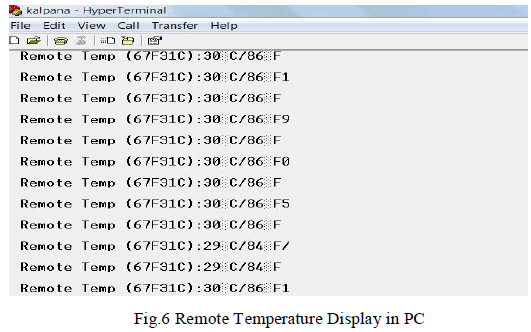 |
| As the same procedure for above sensor using the heart rate, the values of the heart rate values are noted and the information is broadcasted in the network as shown in experimental setup figure 7 and stored the data’s information as shown in figure 8. |
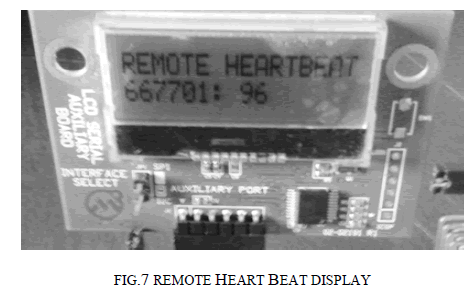 |
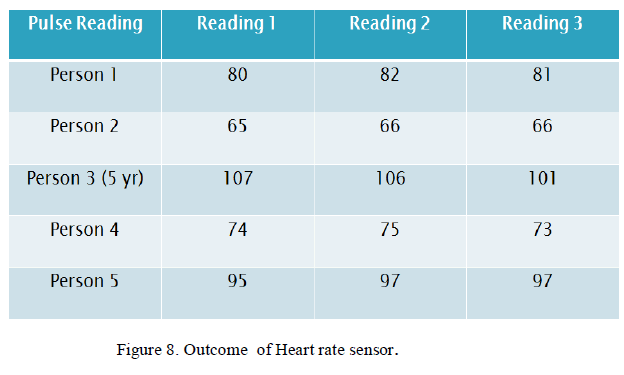 |
RESULT ANALYSIS |
| A. Temperature sensor |
| A temperature sensor was used to proposed sensor design. The tests were performed in water due to the real environment application of the body-sensor. The thermistor is placed together inside the glass of water without any other interference. The water which is had the temperature range of 45âÃÂðC. The water temperature slowly decreased over time due to the temperature of the room. In real time, to verify the collected values through the experimental setup with the temperature calibrator and the voltage on the thermistor terminal. The graph is plotted against voltage vs. temperature. The 'x' axis represents voltage and 'y' axis represents temperature as shown in figure 9. The coefficients are obtained for straight linear regression expression. This expression is used for further calculation. Thus the embedded system is developed by PIC18F46J50 microcontroller to measure the value of the temperature. Regression expression R² = 0.9901 |
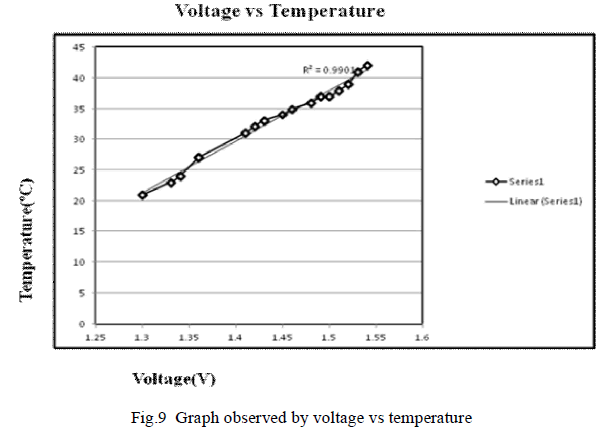 |
| B. PULSE HEART RATE SENSOR |
| To view the heartbeat waveform and check your heart rate, you can use the Processing sketch that we made. The large main window shows a graph of raw sensor data over time. The Pulse Sensor Data Window can be scaled using the scrollbar at the bottom if you have a very large or very small signal. At the right of the screen, a smaller data window graphs heart rate over time. This graph advances every pulse, and the Beats per Minute is updated every pulse as a running average of the last ten pulses. The big red heart in the upper right also pulses to the time of your heartbeat as shown in figure 10. |
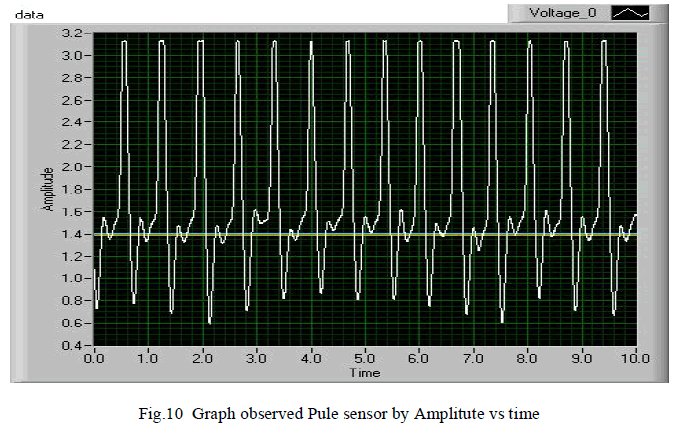 |
CONCLUSION |
| Thus the system successfully develops a wireless architecture for continuous monitoring the human health. The system to get the solution for collecting sensor values is interfaced with the microcontroller and the data is transmitted wirelessly to the server. This system provides reliability and security for independent-living residents with comfort. In this project used to technology a wide range of benefits to patient, medical personnel, and society through continuous monitor the ambulatory setting and early detection of abnormal conditions. Next we will focus on to design a Visual basic design is in progress. |
References |
|